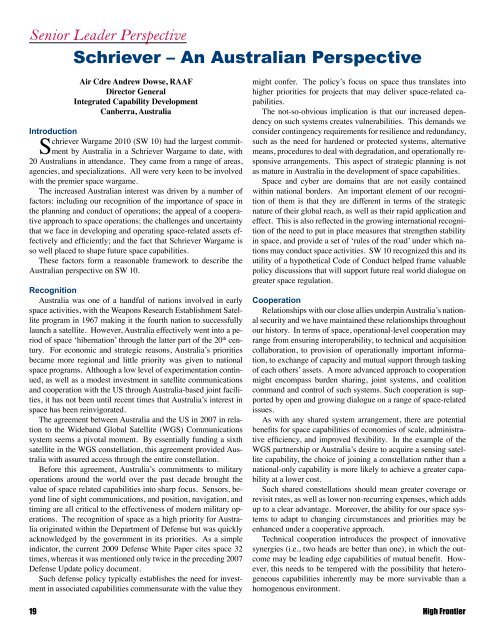Schriever Wargame 2010 - Air Force Space Command
Schriever Wargame 2010 - Air Force Space Command
Schriever Wargame 2010 - Air Force Space Command
Create successful ePaper yourself
Turn your PDF publications into a flip-book with our unique Google optimized e-Paper software.
Senior Leader Perspective<br />
<strong>Schriever</strong> – An Australian Perspective<br />
<strong>Air</strong> Cdre Andrew Dowse, RAAF<br />
Director General<br />
Integrated Capability Development<br />
Canberra, Australia<br />
Introduction<br />
<strong>Schriever</strong> <strong>Wargame</strong> <strong>2010</strong> (SW 10) had the largest commitment<br />
by Australia in a <strong>Schriever</strong> <strong>Wargame</strong> to date, with<br />
20 Australians in attendance. They came from a range of areas,<br />
agencies, and specializations. All were very keen to be involved<br />
with the premier space wargame.<br />
The increased Australian interest was driven by a number of<br />
factors: including our recognition of the importance of space in<br />
the planning and conduct of operations; the appeal of a cooperative<br />
approach to space operations; the challenges and uncertainty<br />
that we face in developing and operating space-related assets effectively<br />
and efficiently; and the fact that <strong>Schriever</strong> <strong>Wargame</strong> is<br />
so well placed to shape future space capabilities.<br />
These factors form a reasonable framework to describe the<br />
Australian perspective on SW 10.<br />
Recognition<br />
Australia was one of a handful of nations involved in early<br />
space activities, with the Weapons Research Establishment Satellite<br />
program in 1967 making it the fourth nation to successfully<br />
launch a satellite. However, Australia effectively went into a period<br />
of space ‘hibernation’ through the latter part of the 20 th century.<br />
For economic and strategic reasons, Australia’s priorities<br />
became more regional and little priority was given to national<br />
space programs. Although a low level of experimentation continued,<br />
as well as a modest investment in satellite communications<br />
and cooperation with the US through Australia-based joint facilities,<br />
it has not been until recent times that Australia’s interest in<br />
space has been reinvigorated.<br />
The agreement between Australia and the US in 2007 in relation<br />
to the Wideband Global Satellite (WGS) Communications<br />
system seems a pivotal moment. By essentially funding a sixth<br />
satellite in the WGS constellation, this agreement provided Australia<br />
with assured access through the entire constellation.<br />
Before this agreement, Australia’s commitments to military<br />
operations around the world over the past decade brought the<br />
value of space related capabilities into sharp focus. Sensors, beyond<br />
line of sight communications, and position, navigation, and<br />
timing are all critical to the effectiveness of modern military operations.<br />
The recognition of space as a high priority for Australia<br />
originated within the Department of Defense but was quickly<br />
acknowledged by the government in its priorities. As a simple<br />
indicator, the current 2009 Defense White Paper cites space 32<br />
times, whereas it was mentioned only twice in the preceding 2007<br />
Defense Update policy document.<br />
Such defense policy typically establishes the need for investment<br />
in associated capabilities commensurate with the value they<br />
might confer. The policy’s focus on space thus translates into<br />
higher priorities for projects that may deliver space-related capabilities.<br />
The not-so-obvious implication is that our increased dependency<br />
on such systems creates vulnerabilities. This demands we<br />
consider contingency requirements for resilience and redundancy,<br />
such as the need for hardened or protected systems, alternative<br />
means, procedures to deal with degradation, and operationally responsive<br />
arrangements. This aspect of strategic planning is not<br />
as mature in Australia in the development of space capabilities.<br />
<strong>Space</strong> and cyber are domains that are not easily contained<br />
within national borders. An important element of our recognition<br />
of them is that they are different in terms of the strategic<br />
nature of their global reach, as well as their rapid application and<br />
effect. This is also reflected in the growing international recognition<br />
of the need to put in place measures that strengthen stability<br />
in space, and provide a set of ‘rules of the road’ under which nations<br />
may conduct space activities. SW 10 recognized this and its<br />
utility of a hypothetical Code of Conduct helped frame valuable<br />
policy discussions that will support future real world dialogue on<br />
greater space regulation.<br />
Cooperation<br />
Relationships with our close allies underpin Australia’s national<br />
security and we have maintained these relationships throughout<br />
our history. In terms of space, operational-level cooperation may<br />
range from ensuring interoperability, to technical and acquisition<br />
collaboration, to provision of operationally important information,<br />
to exchange of capacity and mutual support through tasking<br />
of each others’ assets. A more advanced approach to cooperation<br />
might encompass burden sharing, joint systems, and coalition<br />
command and control of such systems. Such cooperation is supported<br />
by open and growing dialogue on a range of space-related<br />
issues.<br />
As with any shared system arrangement, there are potential<br />
benefits for space capabilities of economies of scale, administrative<br />
efficiency, and improved flexibility. In the example of the<br />
WGS partnership or Australia’s desire to acquire a sensing satellite<br />
capability, the choice of joining a constellation rather than a<br />
national-only capability is more likely to achieve a greater capability<br />
at a lower cost.<br />
Such shared constellations should mean greater coverage or<br />
revisit rates, as well as lower non-recurring expenses, which adds<br />
up to a clear advantage. Moreover, the ability for our space systems<br />
to adapt to changing circumstances and priorities may be<br />
enhanced under a cooperative approach.<br />
Technical cooperation introduces the prospect of innovative<br />
synergies (i.e., two heads are better than one), in which the outcome<br />
may be leading edge capabilities of mutual benefit. However,<br />
this needs to be tempered with the possibility that heterogeneous<br />
capabilities inherently may be more survivable than a<br />
homogenous environment.<br />
19 High Frontier

















